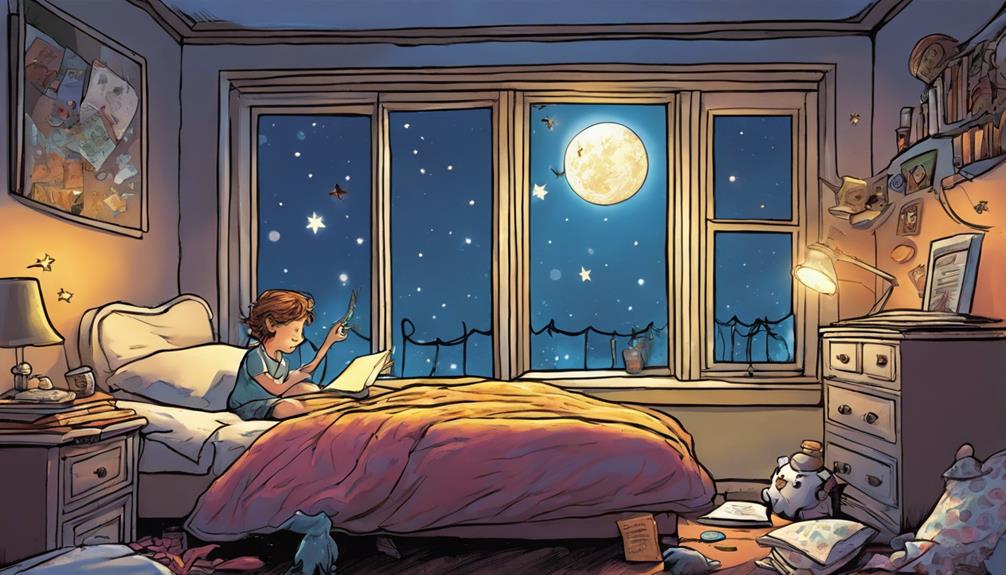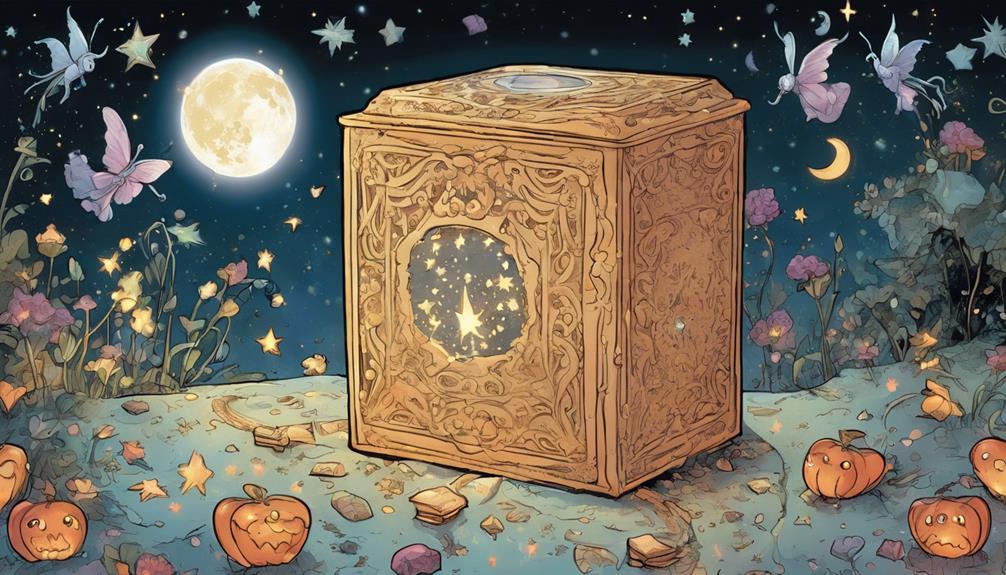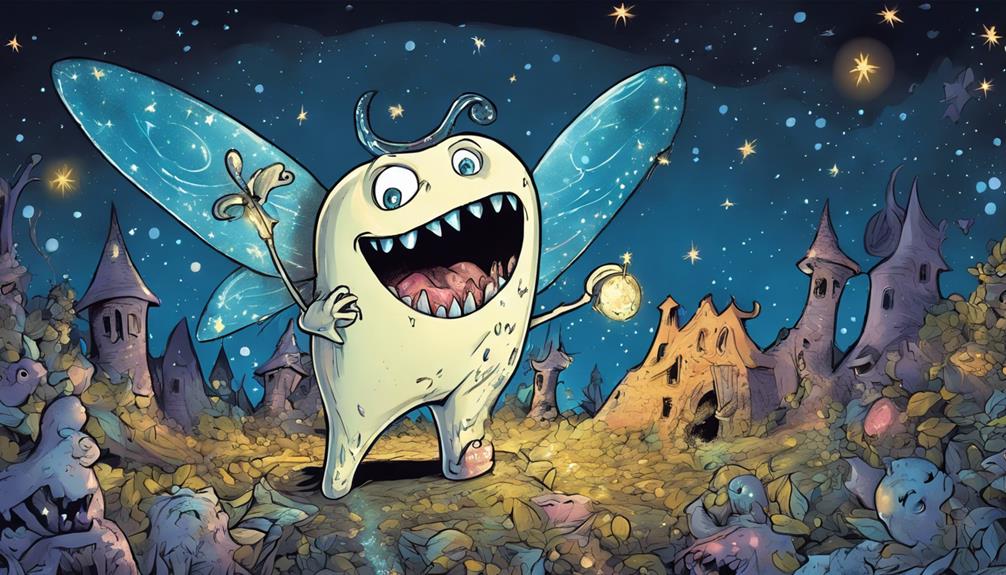The Tooth Fairy's rise to legend is a delightful mix of folklore and childhood magic. You might not know that her roots trace back to 18th-century French tales, where a mouse exchanged teeth for coins. Over time, she transformed into a fairy, spreading joy and excitement during tooth loss. The post-war era saw her popularity soar, with families creating memories through this enchanting tradition. Today, she symbolizes innocence and growth, adapting to modern culture while remaining a beloved figure. If you're curious about her global variations and ongoing relevance, there's much more to discover. Many cultures have their own version of the Tooth Fairy, each with unique customs and folklore surrounding the exchange of lost baby teeth. From the Spanish Ratoncito Pérez to the Korean Tooth Mouse, the tooth fairy’s incredible feats have been adapted and celebrated around the world. Whether she is leaving money, small gifts, or even a special note, the Tooth Fairy continues to bring comfort and wonder to children everywhere. Her timeless appeal and ability to make losing a tooth a magical experience have solidified her place in the hearts of families for generations to come.
Key Takeaways
- The Tooth Fairy originated from European folklore, evolving from a mouse to a magical figure symbolizing childhood innocence and wonder.
- Post-World War II, the Tooth Fairy gained popularity, becoming a cherished tradition that fostered family bonding and created lasting childhood memories.
- Cultural variations, like Ratoncito Perez and rituals in different countries, highlight the universal significance of the Tooth Fairy across diverse traditions.
- The Tooth Fairy has maintained relevance by adapting to modern values, appearing in literature, media, and marketing to engage new generations.
Origins of the Tooth Fairy

The Tooth Fairy's origins lie in European folklore, particularly in an 18th-century French tale about a mouse fairy that set the stage for this beloved tradition. In the story of La Bonne Petite Souris, a mouse fairy plays a pivotal role by rescuing a queen, cleverly hiding a king's teeth under pillows in exchange for coins. This charming tale laid the groundwork for the Tooth Fairy myth, which evolved into a symbol of childhood innocence and wonder.
As children lose their teeth, they enthusiastically anticipate the visit from this whimsical figure who rewards them for their lost treasures. This tradition not only creates excitement but also helps ease the anxiety often associated with losing teeth. The Tooth Fairy represents a rite of passage, marking a significant moment in a child's life.
Over time, the image of the Tooth Fairy has shifted, influenced by good fairy myths and popular media, but the core concept remains the same. Today, she continues to embody joy and magic in homes around the world, solidifying her role as a cherished figure in childhood experiences.
Evolution in Literature

You might be surprised to learn how the Tooth Fairy has evolved in literature since its early references in the 1920s.
After World War II, the tradition gained traction, fueled by post-war prosperity and media portrayals that shaped its cultural presence.
As you explore these changes, you'll see how the Tooth Fairy became a beloved figure in children's folklore.
Early Literary References
Early literary references to the Tooth Fairy reveal a fascinating evolution, starting with an 18th-century French tale that introduced the concept of a fairy dealing with lost teeth. In 'La Bonne Petite Souris,' a mouse fairy transforms into a fairy after rescuing a queen, setting the stage for the legend of the Tooth. This charming narrative captivated imaginations and laid the groundwork for similar stories.
By the 1920s, the first English references emerged, popularizing the idea of exchanging lost teeth for rewards. Parents began to embrace this enchanting concept, which seamlessly blended the thrill of losing a tooth with the excitement of a surprise. As you read these early texts, you can see how the Tooth Fairy evolved from a mouse to a more familiar, whimsical figure, shaping the modern-day version that we're familiar with today.
The evolution in literature reflects changing cultural values around childhood and imagination. These early narratives not only entertained but also provided a comforting ritual for children, reinforcing the Tooth Fairy's role as a beloved figure in folklore. The legend of the Tooth continues to evolve, but its roots are firmly planted in these early literary references.
Post-War Popularity Surge
Post-World War II prosperity sparked a significant surge in the Tooth Fairy's popularity, embedding her deeper into American childhood traditions. Families, enjoying newfound economic stability, embraced and expanded this charming tradition, making it a staple in households across the nation. During this era, children were comforted by the notion of the Tooth Fairy, a whimsical figure who exchanged lost teeth for coins, creating lasting memories.
The Tooth Fairy's roots in literature grew stronger as her presence became more pronounced in children's books and stories. Writers began incorporating her into their narratives, solidifying her role as a comforting cultural icon. Additionally, the 1950s saw an increase in media representations of good fairies, which further elevated the Tooth Fairy's status.
This post-World War II boom in literature and media helped forge a connection between the Tooth Fairy and familial love, making her an integral part of childhood experiences. The establishment of the Tooth Fairy Museum in Deerfield, Illinois, from 1993 to 2000, emphasized her cultural significance and celebrated her evolution as a beloved figure in children's folklore.
Media Influence and Growth
The Tooth Fairy's evolution in literature reflects shifting cultural values and the enduring appeal of whimsical characters in children's storytelling. Her journey began in the 1920s, gaining momentum post-World War II when families could indulge their children. This surge in popularity highlighted the need for comfort and excitement in a world recovering from turmoil.
Media representations in the 1950s cemented the Tooth Fairy's image as a magical figure, often appearing alongside other good fairies in films. These portrayals reinforced her role as a symbol of childhood joy, making her a beloved character in American culture. Over the years, her character has adapted to various storytelling trends, ensuring she remains relevant and engaging for new generations.
The establishment of the Tooth Fairy Museum in Deerfield, Illinois, from 1993 to 2000 further underscored her cultural significance, showcasing the impact she's had on family traditions.
Today, the Tooth Fairy continues to enchant children through books, movies, and digital media, proving that her charm endures amidst changing times. You can see how this delightful character captures hearts, reminding us all of the magic of childhood.
Cultural Significance

The Tooth Fairy tradition brings comfort and excitement to children as they lose their baby teeth, making what could be a stressful experience into a fun ritual.
This figure symbolizes childhood innocence and highlights the universal passage into adolescence.
Across the globe, different cultures adapt the Tooth Fairy concept, showcasing its importance in family traditions and values.
Childhood Comfort and Excitement
Many children find comfort and excitement in the Tooth Fairy legend, turning the loss of baby teeth into a magical milestone. This fairy transforms what could be a stressful experience into a joyful event, allowing kids to embrace change with enthusiasm. As they place their lost teeth under their pillows, they participate in a cherished tradition that reinforces their courage.
The anticipation of waking up to find a small reward fosters a sense of adventure and imagination. For many, this ritual signifies a rite of passage, marking growth in a lighthearted way. It not only eases the anxiety of losing teeth but also creates lasting memories for families.
Parents often join in the fun, engaging in playful rituals that strengthen family bonds. They share stories about the Tooth Fairy, instilling a sense of wonder and excitement in their children. This cultural tradition helps kids navigate the ups and downs of growing up, reminding them that such changes can be celebrated.
The Tooth Fairy, in her whimsical way, provides comfort and joy, ensuring that children feel supported during this important shift in their lives.
Symbol of Innocence
A cherished symbol of childhood innocence, the Tooth Fairy transforms the anxiety of losing teeth into a delightful celebration of growth and imagination. When a child loses a tooth, it can spark fears and uncertainties. However, the Tooth Fairy brings comfort to children, turning this rite of passage into an exciting experience. Instead of dread, they enthusiastically anticipate the magical exchange that awaits them under their pillows.
This figure not only rewards children for their lost teeth but also reinforces bravery, encouraging them to embrace change. The tradition helps children develop a sense of wonder, fostering imaginative play as they dream up stories about the Tooth Fairy's nightly visits. In literature and media, she's portrayed as nurturing and supportive, further enhancing her role as a beloved symbol.
As generations pass, the Tooth Fairy remains a cultural icon, showcasing the imaginative spirit of youth. Her enduring legacy highlights the importance of innocence in childhood, reminding us all of the magic that comes with growing up. By creating a sense of joy around losing teeth, the Tooth Fairy continues to be an essential part of childhood adventures and memories.
Global Traditions Variations
Across the globe, diverse cultures celebrate tooth loss in unique ways, each reflecting their distinct customs and beliefs.
In the Spanish-speaking world, you might encounter Ratoncito Perez, a charming mouse who collects children's lost teeth. This version of the Tooth Fairy emphasizes local folklore, showcasing how global traditions can vary while still centering on the ritual of losing teeth.
In northern Europe, children often receive gifts for losing their sixth tooth, a practice steeped in local customs. Meanwhile, various Indian tribes hold rituals that involve planting lost teeth in sacred grounds, believing it promotes luck and healthy growth of permanent teeth. Tibetan traditions take a different approach, where they crush baby teeth and scatter the powder in the wind, symbolizing a spiritual release.
Across these cultures, the recurring motif of rodents as tooth deities highlights their association with good fortune and growth.
This rich symbolism surrounding dental loss reinforces the significance of these traditions, making the experience of losing teeth a shared yet uniquely celebrated milestone in childhood.
Impact on Families

The Tooth Fairy tradition creates memorable moments that strengthen family bonds during the exciting tooth loss phase. As your child loses teeth, you engage in a delightful narrative that fosters discussions about growth and change. This shared experience helps your child navigate this shifting period positively, reinforcing feelings of security and love.
By incorporating the Tooth Fairy into your family traditions, you promote a sense of magic and excitement that nurtures childhood innocence. You create an environment where imagination thrives, encouraging your child to playfully anticipate the Tooth Fairy's visit. This whimsical practice not only makes losing teeth less intimidating but also adds a layer of joy to the experience.
Interestingly, the average compensation for lost teeth in the U.S. has risen to $3.70, highlighting parents' desire to make this milestone special. These small gestures create lasting memories, allowing you to bond with your child while they embrace the wonder of childhood.
Ultimately, the Tooth Fairy tradition serves as a powerful tool for connection, reinforcing the importance of family in your child's life as they shift through these formative years.
Enduring Legacy

Maintaining her charm, the Tooth Fairy has kept her relevance alive, evolving with each generation while embodying the spirit of childhood innocence and imagination.
You'll find that the history of the tooth is intertwined with this whimsical figure, as children have long celebrated the loss of their baby teeth. By placing a tooth under their pillows, they engage in a ritual that fosters excitement and anticipation.
This tradition not only creates cherished family memories but also adapts to modern values. Today's Tooth Fairy even reflects changes in society, with average compensation for a lost tooth hitting $3.70, showing how families invest in this imaginative experience.
Moreover, the Tooth Fairy's image appears in literature, films, and advertisements, reinforcing her cultural significance. You might notice that dental products have even embraced her charm, using her as a playful mascot to encourage good oral hygiene among children.
The enduring legacy of the Tooth Fairy showcases her remarkable adaptability, reminding us all of the universal themes of growth and change in childhood, making her a beloved figure across generations.
Tooth Fairy Traditions Worldwide

Tooth Fairy traditions vary greatly around the world, each culture adding its unique flair to the age-old ritual of celebrating lost teeth.
In France, kids look forward to visits from La Petite Souris, a charming mouse or rabbit who exchanges lost teeth for rewards, reminiscent of Cinderella's Fairy Godmother in its magical essence.
In Latin cultures, Ratoncito Perez takes center stage. This beloved character not only collects lost teeth but also has a dedicated museum in Madrid that celebrates his rich legacy in tooth folklore.
Northern European traditions emphasize the significance of losing a sixth tooth, often rewarding children with gifts, showing how regional practices can differ widely.
Meanwhile, unique disposal methods exist across cultures; some Indian tribes plant lost teeth in sacred places for good luck, while Tibetans scatter crushed teeth in the wind, embracing a spiritual connection to the act.
Rodents like mice and beavers frequently symbolize the Tooth Fairy, reflecting the idea of continuous tooth growth and the magic tied to these small creatures.
These diverse traditions highlight the enchanting ways people celebrate the passage of childhood.
Modern Relevance

Celebrating lost teeth with the Tooth Fairy remains a beloved tradition for families today, blending nostalgia with modern practices that keep the magic alive. The Tooth Fairy's relevance in the modern-day extends beyond simple exchanges of teeth for coins; she's become a symbol of fun and engaging approaches to dental health education.
Many parents report an average compensation of $3.70 for lost teeth, reflecting her ongoing significance.
Dental practices like MINT dentistry use Tooth Fairy themes in marketing, reinforcing her presence in contemporary culture.
You might notice the Tooth Fairy in advertisements for dental products, highlighting her connection to childhood dental health.
Initiatives like the American Dental Association's 'Ask the Tooth Fairy' advice column help families engage in important discussions about dental care.
Even during challenging times, creative adaptations like the Tooth Fairy Hotline during the COVID lockdown show her adaptability.
Frequently Asked Questions
How Did the Legend of the Tooth Fairy Start?
The legend of the Tooth Fairy started in 18th-century France with tales of a mouse fairy. It gained popularity in English-speaking countries during the 1920s, evolving into a cherished childhood tradition celebrated by families globally.
What Is the Tooth Fairy Urban Legend?
The Tooth Fairy urban legend involves a magical figure who exchanges lost teeth for money or gifts, creating excitement for children. It transforms a natural milestone into a fun, comforting experience during their dental changes.
What Is the Dark Story Behind the Tooth Fairy?
When you lose a tooth, it symbolizes innocence slipping away. The Tooth Fairy, rooted in darker tales, reflects childhood fears and societal anxieties about growing up, transforming a simple ritual into a complex cultural narrative.
What's the Point of the Tooth Fairy?
The Tooth Fairy's point is to make losing teeth a fun, exciting experience for kids. She rewards bravery, fosters family bonding through rituals, and adds a touch of magic to childhood, creating lasting memories.
Conclusion
In a world where kids are glued to their screens, the Tooth Fairy still brings magic to bedtime rituals.
By celebrating the loss of a tooth with a sprinkle of whimsy and a surprise under the pillow, she creates cherished memories that last a lifetime.
So, as you tuck your little one in tonight, remember the power of belief and tradition.
Even in our TikTok age, the Tooth Fairy's charm remains timeless, reminding us all to embrace childhood wonder.









